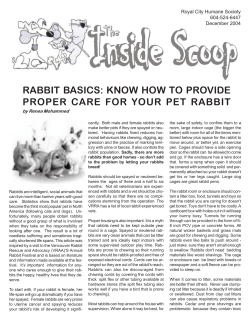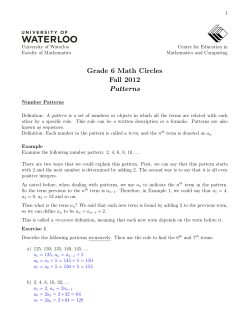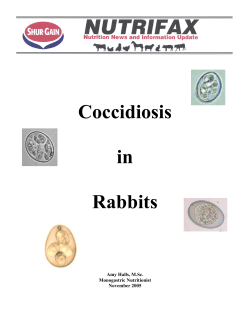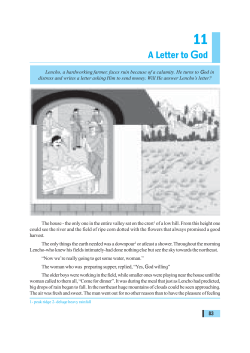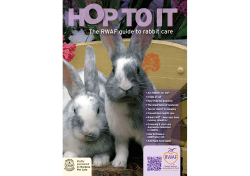
Thank you for adopting a ... make delightful pets with the right care and attention. ...
Thank you for adopting a rabbit from the SPCA. Rabbits can make delightful pets with the right care and attention. They are very sociable animals and enjoy lots of attention from their owner. As well as being rather cute and undeniably lovable, they are also very intelligent creatures and can be easily toilet trained so they can live indoors. When making a rabbit a part of your life it is important to remember that it will rely on you for its every need and will require daily care and attention 365 days of the year. The average lifespan of a rabbit is 5 to 10 years, but they may live as long as 15 years. HANDLING Rabbits need firm but gentle handling from an early age. Rabbits are very social creatures and will love your company but you must let your rabbit get used to its new surroundings for a few days first. It is best to pick up your rabbit by placing one hand under the chest while the other supports the hindquarters, once you have picked it up, hold it comfortably and securely against your chest. Rabbit spines are fragile and can fracture if the hind legs are allowed to dangle and the animal then gives one strong kick; you need to make sure that children know how to handle them properly and are supervised at all times. It is important to keep in mind that rabbits are a prey animal. This means that it is natural for them to be fearful of anything coming down from above to grab them. For this reason it is important not to sneak up on your rabbit and ideally, to give the rabbit a few gentle strokes before picking it up. If your rabbit is particularly nervous and fearful of being picked up it may help to spend some ‘floor-time’ with him. This involves setting up an area where you can get down on the rabbits level and let him get used to your presence. Let the rabbit come and sniff you on his own terms and when he approaches, offer him a treat followed by a gentle pat. Make sure you take things slowly and do not rush things or force the rabbit to be held if he is struggling against you. Remember that the more you handle your rabbit the quieter and friendlier it will be. HOUSING and ENVIRONMENT Rabbits can live happily either indoors or outdoors. If you choose to keep your rabbit outside it will need a good roomy hutch – a MINIMUM of 1.5m (length) x 0.8m (width) x 0.60m (height) is recommended. Most pet shop hutches are too small for rabbits as they need plenty of room to hop around and stand up tall, ideally the height of your hutch should allow your rabbit to stretch up fully when standing on its hind legs. The hutch should have a sleeping compartment that is both water and draft proof and preferably slightly raised off the ground. It should connect to a run (as large as possible) with strong mesh sides to allow air and light to enter. It should also have a mesh floor as most rabbits like to dig and can tunnel out and other predators such as ferrets can tunnel in. It is best if the hutch faces the morning sun but the rabbit must have access to shade during the hot summer and should be protected from the rain and wind during the winter. You must make sure your hutch is predator proof as dogs and cats will kill your rabbit if given the chance. Rabbits are able to be litter trained and so can live happily indoors as part of the family. If you plan to keep your rabbit indoors he will need a safe place to sleep at night and must be supervised when he is loose in the house. Rabbits love to chew so you must ensure your bunny is not able to access electrical cords or potted plants in your house. The best bedding to use is straw, hay or shredded paper atop a layer of newspaper in the sleeping compartment of your rabbit’s hutch. Wood shavings can be used but only if you are absolutely sure they have not been treated and they are not heavily scented. Treated timber or fibre bedding can be fatal if ingested. Rabbits require plenty of exercise and so need to be able to have supervised time running around the backyard or in a large exercise pen with shelter from the weather. They also require mental stimulation so adding features such as ramps, tunnels, boxes and plenty of toys to your rabbit’s home are a must. It is important to remember that our pet rabbits are descended from wild rabbits that live in underground burrows. Our pet rabbits retain the same need to have a protected area in which to feel safe and secure. Try providing your rabbit with boxes (some open and some closed with an entrance hole) and wicker baskets (untreated ones) filled with hay as well as tunnels. Rabbits also like a high point where they can keep a look out for any trouble so it is also a good idea to provide your rabbit with solid objects to jump up on. Providing hidey-holes and toys means that your rabbit will feel much safer and happier. FEEDING Your rabbit needs to be fed a good diet to stay happy and healthy. Rabbits need a diet consisting entirely of vegetable matter. Variety is essential and the food offered must be fresh. Special pellets are available from pet shops and form a good base for the diet which must include hay, green vegetables and grass. When purchasing pellets try to avoid those with dried fruits, nuts, grains and coloured pieces in them as they are high in sugar and salt. A good pellet should ideally have high fibre content (at least 15%) and less protein than fibre. The SPCA feeds and recommends Kaytee Exact Rainbow Pellets which can be purchased from the SPCA and some pet stores. Refer to the feeding instructions on the bag for the appropriate quantities to feed. Usually ½ a cup of pellets per rabbit per day is sufficient if the rabbit is also fed hay and vegetables. Young rabbits up until approx. five months of age can be given an unlimited supply of pellets. Do be aware that over feeding of pellets is a common cause of obesity in rabbits. Use heavy containers for food to avoid spillage, flimsy plastic bowls will be picked up and tossed about by many cheeky rabbits. When changing your rabbits diet or introducing new foods do it gradually, sudden diet change can cause digestive problems which can be harmful and even fatal. Hay is not just used for bedding but is a VITAL part of a rabbit’s diet. Hay provides fibre that is essential to a rabbit’s digestive health. Chewing hay also helps to wear down the continuously growing teeth of a rabbit as well as prevent boredom. Make sure your rabbit has a good sized handful of fresh hay every day. Hay can be purchased from feed stores and some pet shops. Make sure you buy hay that smells fresh and is not damp, dusty or mouldy as this could cause respiratory illness in your rabbit. Fresh water should be available to your rabbit AT ALL TIMES. This can be provided in a pet sipper bottle, a heavy bowl that cannot be tipped over or in a plastic one that clips to the wire of the cage. Remember to check and replace water daily. Fresh fruit and vegetables, especially greens, are an important part of a rabbit’s diet and should be given as often as possible, the more variety the better as this will provide a wide range of nutrients. All vegetables should be introduced slowly, one at a time, and if they cause any diarrhoea then eliminate them from your rabbits diet. Extra care needs to be taken with rabbits under 12 weeks as their stomachs are sensitive and too many greens can upset them. Most fruits are high in sugar so should be fed only as a treat. Below is a list of foods rabbits can and cannot eat. Try to mix and match as much as possible but do not worry too much if you are unable to find a wide range of vegetables – rabbits will appreciate grass just as much as other green vegetables. Treat foods, (like the ones you can buy at a pet shop) are high in sugar and salt and should not be a regular part of a rabbit’s diet. Do not forget that they are just a treat. Sweet things such as chocolate and sugary lollies should not be fed to rabbits even though they would love to eat them. They can cause tooth problems and obesity. Try to stay away from feeding foods high in starch or fat as these foods can cause obesity and sometimes severe digestion problems. These include foods such as beans, breads, seeds, cereals, oats, corn, nuts, wheat and any other grains. Small amounts of rolled oats (1tbsp) or toasted wholemeal bread (¼ of a slice) can be given very occasionally and can be useful if your rabbit needs to gain weight but make sure when feeding these that your rabbit also has access to greens and fresh hay. Treats Limit to very small amounts, 1 or 2 times a week; this includes fresh fruits. Definite No’s: Chocolate Cookies Crackers Breakfast cereal Yoghurt drops Milk Pasta Nuts Bread Most ‘human’ foods Pellets Limited, high-quality pellets (no seeds or dried fruits). Look for those high in fibre. Vegetables Give a variety of fresh greens daily. Hay This should be the staple of your rabbit’s diet DO FEED: Apples Banana Blackberries Blueberries Cranberries Grapes Kiwifruit Mandarins Mango Nectarine Orange Papaya Pears Peach Plums Pineapple Raspberries Raisins Strawberries Watermelon DON’T FEED: Apple Tree Leaves Endive/Chicory Avocado Alfalfa Fresh Picked Grass Beans Fennel Broccoli Buttercup Basil Kale* Broad Beans Borage Lavender Corn on the cob Brussel Sprouts Marjoram Daffodil Butter Lettuce Marigold Foxglove Bok Choy Mint (small amounts) Hemlock Clover Nasturtium Iceberg Lettuce Capsicum Parsley Jasmine Coriander Plantain Kidney Beans Chives Puha Lilies Citrus Tree Leaves Raddish Tops Mushrooms Celery Leaves Rosemary Nightshade Celery Stalks (cut into Romaine/Cos Lettuce Oaks 2cm pieces) Sage (small amounts) Privet Carrots & Tops Spinach* Rhubarb Dandelions Snow Peas Any leaves from evergreen trees. Dill Silverbeet* Dock Leaves (before Watercress Potatoes they have gone to Wheat Grass Snowdrop seed) Sweet pea * = Use sparingly. High in either oxalates or goitrogens and may be toxic in accumulated quantities over a period of time Most of all, rabbits love grass so feed lots of it. Dandelions, puha and dock are common in many gardens just be sure they have not been sprayed and avoid picking them from roadsides. If you are unsure about whether an item is safe to eat don’t feed it – if in doubt, throw it out! HEALTH If your rabbit lives on a healthy diet, has lots of exercise and gets a lot of attention he should live a happy and healthy life. However, things can go wrong and if you are ever in doubt you should talk to your vet. It is important to remember that rabbits are very good at hiding their symptoms as in the wild a sick rabbit is easy prey. Because of this you need to pay close attention to your rabbit’s appearance and behaviour – sometimes what appears to be a rabbit that just looks a bit down is actually a sick rabbit. You need to handle and check your rabbit daily, things to look for in a healthy rabbit are: Weight – a healthy rabbit should be slim and sleek. You should be able to feel the ribs (but not see them) just under the skin without a thick layer of fat. A monthly weigh-in on some scales is a good idea. Eyes, Ears and Nose – should all be clear, clean and bright looking with no discharge. If your rabbit is shaking his head a lot and scratching around the ears this could be a sign of ear mites and he will need to see a vet. Coat – should be shiny, flat and smooth, if you notice any ‘dandruff’ it is quite likely your rabbit has mites which requires treatment by a vet. Rabbits can also get fleas especially if you have cats and/or dogs in your household. If you see any signs of fleas you can treat your rabbit with Advantage which is available at all good vet clinics (make sure you get the one suitable for use on rabbits). You can brush your rabbit with a soft brush to keep his coat looking nice and healthy. Angora and cashmere rabbits need a lot more grooming than other breeds. Your rabbit will moult a few times a year and will require brushing at this time. He may look quite scruffy while he does this. Droppings – rabbits have two sorts of droppings – hard fibrous pellets and soft caecotropes. Rabbits will reingest their caecotropes but usually do this in private. This is a normal and important part of a rabbit’s digestion and does not indicate ill health. Please consult your veterinarian if you see a large number of caecal pellets in the cage because your rabbit may be missing vital nutrition. If a rabbit is eating a diet that is too high in protein (such as one that contains mostly commercial pellets) there may be caecotropes dropped in the cage that are excess to requirements, if this occurs cut back on high protein foods and increase fibre intake. One of the most dangerous things for a rabbit to get is diarrhoea; this can be fatal in rabbits. If this occurs stop feeding any fruit and vegetables, etc. until you can work out what has caused it. If it continues please get your rabbit looked at by a vet. Teeth – Rabbits teeth grow throughout its life and teeth problems are common. Make sure you provide your rabbits with adequate chewing material such as willow, apple and citrus tree branches (dried) to keep the teeth worn down. Any reluctance to eat or drooling may indicate a tooth problem that should be checked out by a vet. Vaccinations – Calici Virus is now present in New Zealand and is a fatal disease if contracted. Most rabbits don’t show a lot of symptoms and can die within a few hours. A vaccine is available at your local vets but ring around first as prices differ. Claws – your rabbits nails will need clipping regularly (about once every six to eight weeks). If you are unsure as to how to do this then ask your vet to show you how as you can easily cut through the blood vessel. A paving stone or a flat river stone placed in an area the rabbit regularly travels over may help reduce the need to trim nails as often though. Happiness is also extremely important; a happy rabbit will be a healthier rabbit. In the wild a rabbit will live amongst other rabbits and have a home range of around 2 hectares so be aware that by confining your rabbit to a hutch you are taking away some of his natural instincts and pleasures in life. To compensate for this make sure you spend time with your rabbit as often as possible so that he is not lonely and create a space where he can munch on grass, run around, and dig to his hearts content! BUNNY BONDING It is also a good idea to get your rabbit a friend especially if you feel you will not be able to provide enough company as rabbits are very sociable creatures and often crave the companionship of their own kind. They form bonds that are so powerful that the loss of a companion can cause depression and illness. Although they love and thrive with companionship the bonding process can be slow and may take patience, time and commitment for you to foster the relationship. You will need separate housing for both individual animals until successfully bonded. Before attempting an introduction of both rabbits it is highly recommended both rabbits are desexed. Bonding is generally easier if both are fixed. To be safe you need to wait about 5-6 weeks after surgery before attempting introductions. This allows the rabbits to heal and his or her hormones to balance. Males can also stay fertile within this time and any unfixed females should remain separated to avoid pregnancy. The best match is a neutered male and spayed female and they are likely to get along better than any other combination. It is possible for rabbits of the same sex to live happily together if introduced at a young age but when they reach puberty (3-6 months of age) they may start fighting. If they are desexed prior to puberty this greatly decreases the chance of fighting and it is likely they will live happily together. An adult rabbit will not get along with another rabbit of the same sex unless both of them are desexed prior to introduction and even then it can be difficult to get them to live happily and requires much patience. Once two rabbits bond with each other they bond for life and must not be separated as this would cause a great deal of emotional trauma to them both. Do not get a guinea pig for company. Guinea pigs and rabbits are two different species with different nutritional and living requirements, not only that but they do not speak the same language and problems communicating can lead to aggression towards each other. Some people have had success keeping the two together but one kick from a rabbit can kill a guinea pig and a bite from a guinea pig, if it goes unnoticed, can lead to infections and abscesses. When introducing two rabbits that have never met it is best to get them acquainted with each other’s sight and smell first. Try positioning their hutches beside each other so they are able to see each other and get used to each other’s presence. After about a week swap the two rabbits around so they can get fully acquainted with each other’s smell. After another week you can try putting them together for the first time. This is best done in a neutral territory – somewhere that neither rabbit has been before as rabbits are extremely territorial and may exhibit behaviours such as territorial droppings, urinating and aggressive behaviour such as chasing, biting or mounting. Rabbits are not quick to forget, so an initial fight could hinder future bonding success. It is a good idea to have a water bottle handy so you can squirt them if they begin to be aggressive with each other. You should also have a towel handy so that if a serious fight breaks out you can use it to pick one rabbit up. Whatever you do don’t put your hand between them as rabbits have very sharp teeth and you are likely to be bitten in this situation, gloves and a longsleeved shirt are a good idea. Bunnies like humans have very different personalities. When two bunnies meet initially, several outcomes may occur: A tentative friendship. They will keep an eye on each other and may approach and sniff but will not groom each other. Sometimes the date consists of one chasing/one running. Make sure the one chasing does not start fighting and that the other is not getting hurt. They may require a longer introduction period before they fully bond and will need more work/attention to building a relationship. Sometimes one rabbit mounts the other. This is OK as long as the rabbit on the bottom (submissive) is accepting it. They are working out who is the boss. The tables may turn later in the same date. Make sure both bunnies noses can be seen so they are not biting in sensitive areas during interaction. Mounting may be done by any rabbit regardless of gender or size. It is a form of communication and establishing dominance, it will likely stop or lessen over time as the rabbits relationship solidifies. Less common, but possible, is love at first sight. The bunnies may groom each other or cuddle with each other. Success. Also uncommon, but possible is outright fighting. Separate the rabbits immediately to prevent them from hurting each other. This will be a harder relationship to build but it can be done. Work with the rabbits daily for at least 15 minutes. The more often you work with them the faster the bonding process will hopefully be. If the rabbits have a bad experience, or if one of the rabbits is elderly or has health considerations, you may need to take it slower or take some time off. Rabbits that are not fully bonded need to be kept separate when you are not with them. It can take a few weeks to a few months to combine two rabbits into a bonded pair. Once the rabbits have bonded do not separate them. If one goes to the vet, take both, the sick rabbit will be less stressed and more likely to recover if its mate is with it. If they are apart and one comes back with a different smell or change in health they may reject each other and begin fighting. Besides if one appears ill it is best to get both checked as anything contagious will most likely affect both. FOR MORE INFO If you are having difficulty with your rabbit or would like more information please do not hesitate to contact the Auckland SPCA on (09) 256 7300. Some good rabbit websites These website’s hold all sorts of information on caring for your new pet rabbit. Reading up as much as possible can help enrich your wealth of knowledge and enrich the lifestyle of your pet too. We recommend you utilize several, to attain the broadest knowledge available. Some may have slightly differing information so use your discretion. www.rabbit.org www.carrotcafe.com www.bunnybusiness.org www.fuzzy-rabbit.com www.rabbitwelfare.co.uk www.myhouserabbit.com www.rabbitcare.org www.aquavet.i12.com/Rabbit.htm http://homepage.mac.com/mattocks/morfz/rabrefs.html http://exoticpets.about.com/cs/rabbits/a/rabbitcare.htm *The SPCA Auckland has provided these websites as a helpful guide only. We are not contributors and take no responsibility for any of information listed on these sites.
© Copyright 2025
